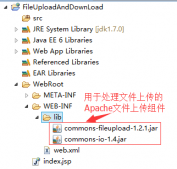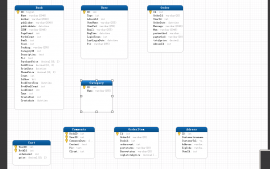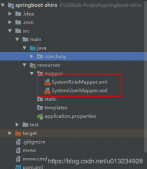题目:使用struts2自定义拦截器,完成用户登陆才能访问权限的实现
- 在session中存放user变量表示用户登陆,若user为空则用户没有登陆,反之登陆
- 显示提示信息(请先登录)
定义拦截器
在struts.xml中定义拦截器使用标签<Intercaptors>、<Intercapter>。
|
1
2
3
4
5
6
7
|
<interceptors> <interceptor name="test" class="Intercaptor.Intercaptor" /> <interceptor-stack name="testStack"> <interceptor-ref name="defaultStack"/> <interceptor-ref name="test" /> </interceptor-stack></interceptors> |
注:当我们为某个action添加Intercaptor时就会放弃struts2的其他的拦截器,所以我们要把自定义的拦截器放在一个一个拦截器栈中。
name属性就是Intercaptor.Intercaptor类在服务器上的一个实例
class属性就是这个拦截器的的类
实现拦截器
拦截器的java类要实现Intercaptor这个接口和里面的方法intercept()。我们这里拦截的条件是用户是否登陆,也就是session中的user变量是否为空。
|
1
2
3
4
5
6
7
8
9
10
11
12
13
14
15
16
17
18
|
public class Intercaptor implements Interceptor{ public void destroy() { } public void init() { } public String intercept(ActionInvocation invocation) throws Exception { Object user=ActionContext.getContext().getSession().get("user"); if(user!=null){ return invocation.invoke(); } ActionContext.getContext().put("message", "请先登陆"); return "success"; }} |
实现业务逻辑
在action中添加拦截器
|
1
2
3
4
|
<action name="Action" class="Action.Action"> <interceptor-ref name="test"></interceptor-ref> <result name="success">Message.jsp</result></action> |
其他
action的实现
|
1
2
3
4
5
6
7
8
9
10
11
12
13
14
15
|
public class Action extends ActionSupport{ private String message; public String getMessage() { return message; } public void setMessage(String message) { this.message = message; } public String execute() throws Exception { return "success"; }} |
index.jsp
|
1
2
3
4
5
6
7
8
|
<body> 用户状态:${user!=null?"已登陆":"未登陆"}<br> <a href="UserLogin.jsp" rel="external nofollow" >用户登陆</a> <a href="UserQuit.jsp" rel="external nofollow" >用户退出</a> <form action="<%request.getContextPath(); %>/testIntercaptor/Action"> <input type="submit" value="登陆后的操作"> </form></body> |

UserLogin.jsp
在request.getSesssion中存放user变量
|
1
2
3
4
5
6
7
|
<%@ page language="java" import="java.util.*" pageEncoding="utf-8"%> 登陆成功 <% request.getSession().setAttribute("user", "user"); response.setHeader("refresh", "1;url=index.jsp"); %> |
UserQuit.jsp
移除request.getSesssion中user变量
|
1
2
3
4
5
6
7
|
<%@ page language="java" import="java.util.*" pageEncoding="utf-8"%> 退出成功 <% request.getSession().removeAttribute("user"); response.setHeader("refresh", "1;url=index.jsp"); %> |
Message.jsp
简单是输出message和debug
|
1
2
3
4
|
<body> ${message } <br/><s:debug></s:debug></body> |
以上就是本文的全部内容,希望对大家的学习有所帮助,也希望大家多多支持服务器之家。
原文链接:http://www.jianshu.com/p/fc9e8ef59790?utm_source=tuicool&utm_medium=referral















